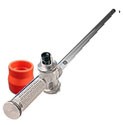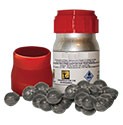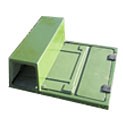About Rabbits
Rabbits are social animals, living in medium-sized colonies known as warrens.
They are largely crepuscular, being most active around dawn and dusk, although they are not infrequently seen active during the day.
During the day, rabbits prefer to remain undercover in gorse, long grass or bushes which they use for protection from predators.
At night, they move into open areas to feed.
Rabbits require at least 55% water content in their diet to reproduce successfully and to maintain a healthy condition.
Rabbits are essentially mixed-feeders, both grazing and browsing, but grass is their primary food source.
They nevertheless have a diverse diet of grasses, leaves, buds, tree bark, and roots. They will also eat lettuce, cabbage, root vegetables, and grains.
Rabbit Reproduction, “Breeding Like Rabbits”
It is a well-known fact that rabbit reproduce quickly.
What most people fail to appreciate is just how quickly.
They can breed from just three to four months of age.
They can produce four to seven litters of offspring per year; and some mature females can be pregnant continuously for up to eight months and are capable of becoming pregnant again a few hours after giving birth.
One single pair of mature rabbits is able to produce 30-40 offspring per year.
One quite stunning example of the reproductive powers of the rabbit is what happened when the rabbit was introduced to Australia.
Twenty-four European rabbits were introduced in 1859 by estate owner Thomas Austin in Victoria.
They soon spread throughout the country due to the lack of natural predators. Widespread farming practices at the time produced an ideal habitat, and mild Australian winters allowing them to breed year-round.
By the early 1900s that original 24 individuals had produced a population of almost 600 Million.
RABBIT CONTROL METHODS
Shooting

Traditionally, shooting has been used to control rabbits since the invention of the gun and this method continues to be used today.
Shooting as a control method is fine for a small population of rabbits, but is ineffective where control is needed for larger populations.
Shooting is best done at night using lamps to pick out rabbits and illuminate them to allow for a clean shot to be taken, however rabbits can become habituated to the lights and quickly become lamp shy, making shooting increasingly difficult and adversely affecting any shooting programme.
Burrow Fumigation or Gassing

Burrow fumigation or gassing as it is commonly known, is a highly effective method of controlling any burrowing animal and one our operatives have used effectively for many years.
Phosphine gas in pellet form is introduced to the warren system.
The pellets react with moisture in the soil and emit phosphine gas which sinks into the burrow system.
Gassing of burrows should only be carried out by qualified licensed operatives who have attended the relevant training and have completed comprehensive risk assessments before each application.
Our gassing team all hold the relevant LANTRA qualification.
Gassing Costs

The gassing of burrows is often thought of as being expensive to carry out.
In our experience this is not the case.
Whilst it is correct to say that there is a cost to purchasing the gas pellets, the labour cost associated with this method are reduced in comparison to any other method so costs generally work out the same.
In comparison to other methods, rabbit populations can be brought under control quicker and the effectiveness of the programme is more predictable.
Rabbit Drop Boxes

The use of drop boxes to control rabbits can be very effective.
Drop boxes are a type of multiple live catch trap which works in conjunction with rabbit proof fencing. Normally, however, they can be installed along chain link and most types of panel fencing.
They are usually placed along the pathways used by rabbits and work by funnelling the rabbits through a tunnel and through a hinged trap door into a holding box below.
These boxes work best when placed at gaps in fencing through which rabbits are moving.
They also allow for the safe release of any non-target species which are accidentally caught in the trap.
Burrow Flushing
Burrow flushing involves introducing either ferrets or irritant smokes into a burrow or warren system which flushes the rabbits from the burrows and into waiting nets.
We carry out burrow flushing usually in winter or on wet days when gassing cannot be safely carried out.
Burrow flushing can also be used as a final check to ensure gassing has been effective.





